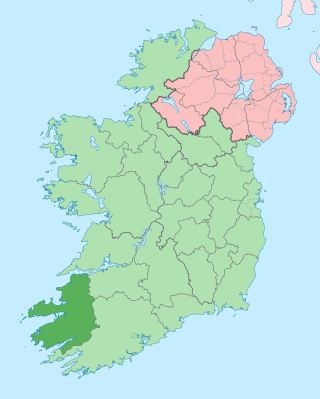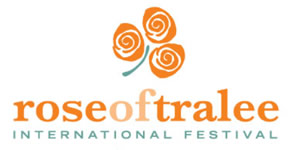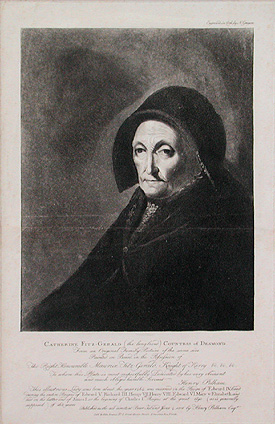Related Research Articles

County Kerry is a county in Ireland. It is in the Southern Region and the province of Munster. It is named after the Ciarraige who lived in part of the present county. The population of the county was 156,458 at the 2022 census.

Tralee is the county town of County Kerry in the south-west of Ireland. The town is on the northern side of the neck of the Dingle Peninsula, and is the largest town in County Kerry. The town's population was 26,079 as of the 2022 census, making it the 15th largest urban settlement in Ireland. Tralee is known for the Rose of Tralee International Festival, which has been held annually in August since 1959.

The Rose of Tralee International Festival is an event which is celebrated among Irish communities all over the world. The festival, held annually in the town of Tralee in County Kerry, takes its inspiration from a 19th-century ballad of the same name about a woman called Mary, who because of her beauty was called "The Rose of Tralee". The words of the song are credited to C. Mordaunt Spencer and the music to Charles William Glover, but a story circulated in connection with the festival claims that the song was written by William Pembroke Mulchinock, a wealthy Protestant, out of love for Mary O'Connor, a poor Catholic maid in service to his parents.

Ardfert is a village and civil parish in County Kerry, Ireland. Historically a religious centre, the economy of the locality is driven by agriculture and its position as a dormitory town, being only 8 km (5 mi) from Tralee. The population of the village was 749 at the 2016 census.

Askeaton is a town in County Limerick, Ireland. The town is built on the banks of the River Deel which flows into the Shannon Estuary 3 km to the north. Askeaton is on the N69 road between Limerick and Tralee; it is 25 km west of Limerick and 8 km north of Rathkeale.

The Ardfert Cathedral is a ruined cathedral in Ardfert, County Kerry, Ireland. Dedicated to Saint Brendan, it was the seat of the Diocese of Ardfert from 1117. It is now a heritage tourism site.

Gerald FitzGerald, 14th Earl of Desmond, also counted as 15th or 16th, owned large part of the Irish province of Munster. In 1565 he fought the private Battle of Affane against his neighbours, the Butlers. After this, he was for some time detained in the Tower of London. Though the First Desmond Rebellion took place in his absence, he led the Second Desmond Rebellion from 1579 to his death and was therefore called the Rebel Earl. He was attainted in 1582 and went into hiding but was hunted down and killed.

Katherine FitzGerald, Countess of Desmond was a noblewoman of the Anglo-Norman FitzGerald dynasty in Ireland. English writers of the Tudor period, including Sir Walter Raleigh, helped popularise "the old Countess of Desmond" as a nickname for her, due to her longevity. One estimate placed her age at death in excess of 120 years. Another ranged as high as 140. Most likely she lived to about 100. A recent biography of the countess suggested that Katherine was at least 90 when she died.
Sir Maurice FitzGerald, 14th Knight of Kerry fought for James II in the Williamite War in Ireland, but after the defeat he conformed to the established religion by joining the Church of Ireland. He became Deputy Lieutenant of Kerry.

Ballyseedy is a townland in County Kerry, Ireland. It was historically situated in the parish of Ballyseedy, within the barony of Trughanacmy. The townland contains a number of notable landmarks, including Ballyseedy Wood, a bridge over the Ballycarty River and a ruined Protestant church. There is also a large restored castle which is in use as a hotel.

Blennerville is a small village near Tralee, County Kerry, Ireland. It is approximately 1 mile (1.6 km) west of the town centre on the N86 road to Dingle, where the River Lee enters Tralee Bay. The village was formerly Tralee's port, and is connected to the town centre by the Tralee Ship Canal. Part of Blennerville electoral division falls within the area of Tralee Town Council, and at the 2011 census had a population of 141. The remaining portion, outside the urban boundaries, had a 2011 population of 556.
The High Sheriff of Kerry was the British Crown's judicial representative in County Kerry, Ireland from the 16th century until 1922, when the office was abolished in the new Free State and replaced by the office of Kerry County Sheriff. The sheriff had judicial, electoral, ceremonial and administrative functions and executed High Court Writs. In 1908, an Order in Council made the Lord-Lieutenant the Sovereign's prime representative in a county and reduced the High Sheriff's precedence. However, the sheriff retained his responsibilities for the preservation of law and order in the county. The usual procedure for appointing the sheriff from 1660 onwards was that three persons were nominated at the beginning of each year from the county and the Lord Lieutenant then appointed his choice as High Sheriff for the remainder of the year. Often the other nominees were appointed as under-sheriffs. Sometimes a sheriff did not fulfil his entire term through death or other event and another sheriff was then appointed for the remainder of the year. The dates given hereunder are the dates of appointment. All addresses are in County Kerry unless stated otherwise.
Castle Conway is a former castle and stately home in the town of Killorglin, County Kerry, Ireland. Today only the ruins of one wall remain.
Sir William Godfrey, 1st Baronet (1739–1817) was an Anglo-Irish member of the Irish House of Commons.
Colonel Sir Rowland Blennerhassett, 1st Baronet was an Anglo-Irish lawyer and baronet.

Jackie (John) Ryan was an Irish Gaelic footballer who primarily played as a Half Forward as well as in the Full Forward line for the Kerry senior team between 1924 and 1934. Ryan won six All-Ireland Senior Football medals with Kerry over his ten-year career, and received favorable reviews.
Arthur Blennerhassett Rowan, (1800–1861) was a Church of Ireland cleric, Archdeacon of Ardfert from 1856 to 1861, known also as an antiquarian writer.
Anne Margaret Rowan was an Irish novelist, historian, and political activist.
Richard Ponsonby was an Irish member of parliament (MP) for a County Cork constituency and a justice of the peace (JP) for County Kerry.
James Carrique Ponsonby [also recorded as Carrigue, Carigue, Carique and Carrick] was an Irish member of parliament (MP) for two different constituencies, high sheriff, justice of the peace and grand juror of County Kerry and an important Irish landowner.
References
- 1 2 "Holdings: Copy letter from Mary Agnes Hickson, antiquarian,..." Catalogue. Retrieved 25 October 2019.
- ↑ "Will probate" (PDF).
- 1 2 "The Old Countess, the Geraldine knight and the lady antiquarian: a conspiracy theory revisited". History Ireland. 7 May 2013. Retrieved 25 October 2019.
- 1 2 Hickson, M.A. (1872). Selections from Old Kerry Records: Historical and Genealogical, with Introductory Memoir, Notes and Appendix. Selections from Old Kerry Records: Historical and Genealogical, with Introductory Memoir, Notes, and Appendix. Watson & Hazell. Retrieved 25 October 2019.
- 1 2 Hickson, M.A. (1884). Ireland in the Seventeenth Century; Or, The Irish Massacres of 1641-2,their Causes and Results. Longmans, Green. Retrieved 25 October 2019.
- 1 2 Smith, N. (2006). A 'Manly Study'?: Irish Women Historians 1868-1949. Palgrave Macmillan UK. p. 15. ISBN 978-0-230-59648-1 . Retrieved 25 October 2019.
- ↑ "Ardfert Franciscan Friary | Monastic Ireland".
- 1 2 Murphy, J. Memories of Old Tralee by Miss A M Rowan. Lulu.com. p. 33. ISBN 978-1-326-82517-1 . Retrieved 25 October 2019.
- 1 2 Murphy, J.A. The Obituary Book. Lulu.com. p. 87. ISBN 978-1-291-40946-8 . Retrieved 25 October 2019.
- 1 2 "Mary Agnes Hickson and the Earls of Desmond". The Michael O'Donohoe Memorial Heritage Project. 2 October 2018. Retrieved 25 October 2019.
- ↑ Jevons, W.S. (1977). Papers and Correspondence of William Stanley Jevons: Volume V Correspondence, 1879â€"1882. Palgrave Macmillan UK. p. 10. ISBN 978-1-349-03094-1 . Retrieved 25 October 2019.